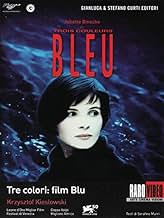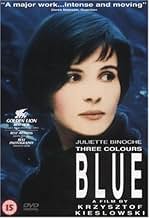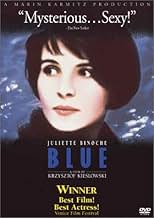A woman struggles to find a way to live her life after the death of her husband and child.A woman struggles to find a way to live her life after the death of her husband and child.A woman struggles to find a way to live her life after the death of her husband and child.
- Awards
- 21 wins & 19 nominations
Benoît Régent
- Olivier
- (as Benoit Regent)
Charlotte Véry
- Lucille
- (as Charlotte Very)
Hélène Vincent
- La journaliste
- (as Helene Vincent)
Yann Trégouët
- Antoine
- (as Yann Tregouet)
Storyline
Did you know
- TriviaAt the 2018 Visegrad Film Forum, cinematographer Slawomir Idziak claimed that the script and initial cut of this film focused on the journalist character (played by Hélène Vincent) and her efforts to investigate the authorship of the unfinished musical composition that drives the plot. It was only during the editing process that director Krzysztof Kieslowski re-structured the film to focus on Julie (played by Juliette Binoche).
- GoofsThe speech given at the funeral states Julie's daughter's age as 5, but the dates on the coffin (26/04/1985 - 07/09/1992) would make her 7 years old.
- Quotes
Julie Vignon: Now I have just one thing left to do: nothing. I want no possessions, no memories, no friends, no lovers -- they're all traps.
- Crazy creditsThe final credit says in French, "We thank Alfa Romeo who allowed the scene of the accident to the Alfa 164 whose dynamics are of course purely imaginary."
- ConnectionsFeatured in The 51st Annual Golden Globe Awards (1994)
Featured review
BLEU (TROIS COLEURS) / France/Poland 1993 (4 STARS) 23 January 2004: The thing that stands out most about Blue is the expression (or lack there of) of grief. How does a woman, seemingly fulfilled by happiness, react when that happiness is yanked away in one telling moment, in a car accident in which both her husband and her daughter pass away? That is the central understudy - a strong woman's attempts at finding purpose in the seeming absence of meaning. Mise-en-scene: I watched an interview with Juliette Binoche, where she mentions that Kieslowski refused to make the film unless it had her in it. It's easy to see why. I can't imagine Bleu without Juliette its not just that she lends her personality to the film
Bleu IS Binoche.
I was thrown off by the sub-plots of the character's relationships with her mother and the striptease dancer, as I was about the seeming resolution at the end of the film. There were perhaps references that I missed but the almost happy' ending left me feeling un-relinquished. Given that I had shared such an intense journey with Julie, it seemed almost improper to accept that she would settle in to a normal relationship again.
Cinematography: The 1st shot of the film - that of a car tire racing - shot from the bottom of the moving car establishes this as not your typical movie'. The sequence-of-shots that follow eerily draw one into the compelling story-telling style of Krzysztof Kieslowski, minimalist in its approach, with a world communicated without dialogue in the first five minutes of the film. Blue is not your typical art-house film. Its production values are up there with the best, and the cinematography by Slavomir Idziak (who's craft was recognized by Hollywood in Black Hawk Down), is nothing short of stunning. The lighting is low key and soft, and wraps around the characters to create a mood of subtlety. A distinguishing feature is the detail in the shadows. None of the close-ups fully illuminate the protagonist, almost hinting at her vulnerability at facing the light, though the delicate use of eye-lights does well to bring alive her emotions. The camera, an intelligently used narrative element, interacts with Julie and partakes in her emotions, respecting them and yet accentuating their intensity as she plods on in an alien world of deep personal purposelessness. The tight close-ups penetrate her soul and force us to delve into Julie's mind and share in her agony. Editing: deftly uses match on action to create irony while forwarding the narrative. Sound: The pace is hauntingly slow and silence has been used compellingly. It screams with meaning as it is becomes one of the more important elements as the narrative progresses. Bleu is not a film you can watch, consume and move on. Either you'll feel that you've totally wasted your time and will probably not be able to sit through (the pivotal occurrence is over within the first five minutes of the film without a single world being spoken, and the rest of the film is essentially the protagonist's psychologically subjective journey) or you'll realize by the time you've reached the end that you'll revisit this film at various points in time, explore and read about it, discuss it with people you respect, and try to get closer to the essence of Kieslowski. For there are two now well-accepted truths about the folklore surrounding Kieslowski, whose reputation continues to mount posthumously 1. that Kieslowski carefully interwove elements that were rich with meaning and social irony, and 2. that figuring those elements out and appreciating their implications is probably a lifelong learning process.
I was thrown off by the sub-plots of the character's relationships with her mother and the striptease dancer, as I was about the seeming resolution at the end of the film. There were perhaps references that I missed but the almost happy' ending left me feeling un-relinquished. Given that I had shared such an intense journey with Julie, it seemed almost improper to accept that she would settle in to a normal relationship again.
Cinematography: The 1st shot of the film - that of a car tire racing - shot from the bottom of the moving car establishes this as not your typical movie'. The sequence-of-shots that follow eerily draw one into the compelling story-telling style of Krzysztof Kieslowski, minimalist in its approach, with a world communicated without dialogue in the first five minutes of the film. Blue is not your typical art-house film. Its production values are up there with the best, and the cinematography by Slavomir Idziak (who's craft was recognized by Hollywood in Black Hawk Down), is nothing short of stunning. The lighting is low key and soft, and wraps around the characters to create a mood of subtlety. A distinguishing feature is the detail in the shadows. None of the close-ups fully illuminate the protagonist, almost hinting at her vulnerability at facing the light, though the delicate use of eye-lights does well to bring alive her emotions. The camera, an intelligently used narrative element, interacts with Julie and partakes in her emotions, respecting them and yet accentuating their intensity as she plods on in an alien world of deep personal purposelessness. The tight close-ups penetrate her soul and force us to delve into Julie's mind and share in her agony. Editing: deftly uses match on action to create irony while forwarding the narrative. Sound: The pace is hauntingly slow and silence has been used compellingly. It screams with meaning as it is becomes one of the more important elements as the narrative progresses. Bleu is not a film you can watch, consume and move on. Either you'll feel that you've totally wasted your time and will probably not be able to sit through (the pivotal occurrence is over within the first five minutes of the film without a single world being spoken, and the rest of the film is essentially the protagonist's psychologically subjective journey) or you'll realize by the time you've reached the end that you'll revisit this film at various points in time, explore and read about it, discuss it with people you respect, and try to get closer to the essence of Kieslowski. For there are two now well-accepted truths about the folklore surrounding Kieslowski, whose reputation continues to mount posthumously 1. that Kieslowski carefully interwove elements that were rich with meaning and social irony, and 2. that figuring those elements out and appreciating their implications is probably a lifelong learning process.
- Abhijoy-Gandhi-WG05
- Jan 22, 2004
- Permalink
- How long is Three Colors: Blue?Powered by Alexa
Details
- Release date
- Countries of origin
- Official site
- Languages
- Also known as
- Ba Sắc Màu: Xanh
- Filming locations
- Palais de Justice, Paris 1, Paris, France(hall of justice)
- Production companies
- See more company credits at IMDbPro
Box office
- Gross US & Canada
- $1,324,974
- Opening weekend US & Canada
- $6,413
- Dec 5, 1993
- Gross worldwide
- $1,518,216
- Runtime1 hour 34 minutes
- Color
- Sound mix
- Aspect ratio
- 1.85 : 1
Contribute to this page
Suggest an edit or add missing content


![Watch Bande-annonce [OV]](https://m.media-amazon.com/images/M/MV5BZGFhMTA5ODQtM2Q4OC00NTI0LTkyYjgtMGViODA0YWZjZmI3XkEyXkFqcGdeQXRyYW5zY29kZS13b3JrZmxvdw@@._V1_QL75_UX500_CR0)
![Three Colors: Blue: The Criterion Collection [Blu-ray]](https://m.media-amazon.com/images/M/MV5BZThmZGMzY2EtZTdiNy00NjMwLTk1YTQtOTVlNGIxYjRhZGYzXkEyXkFqcGdeQXVyNzU1NzE3NTg@._V1_QL75_UX500_CR0)































